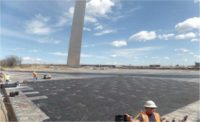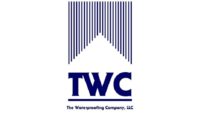Open park space within urban environments is vital to the development and general well-being of the surrounding communities. As the population in these areas continues to grow and become denser, finding creative ways to incorporate dedicated park spaces becomes more imperative. Options may include transforming industrial areas into parks and community gardens and installing green-roof systems on a variety of structures.
Chicago-based Western Waterproofing Co., a member company of Western Construction Group, recently completed a mammoth project to restore and waterproof a 750,000-square-foot concrete parking garage (equivalent to 12 football fields) underneath the newly designated, 20-acre Maggie Daley Park in Chicago. The park opened in December 2014 and includes a 40-foot-tall rock climbing wall, play garden and ice-skating ribbon that can accommodate 700 skaters at one time.
Formerly known as North Grant Park/Daley Bicentennial Plaza, Maggie Daley Park is part of a larger network of adjacent parks including Millennium Park to the west and Grant Park to the south—an entire park system was built on top of underground garages. Together these interconnected garages comprise the largest parking facility in the country.
The $60 million project was divided into three phases—removal of the existing park by James McHugh Construction Company; waterproofing and repairs to the concrete parking structure by Western Construction Group and re-installation of the park and construction of its new features by Walsh Construction.
The Process
The concrete parking structure, originally waterproofed in the 1970s, had become compromised from years of wear and tear and ground water infiltration. Should any leaks or drainage issues occur to the garage in the future, the new park and its amenities would have to be pulled up and the entire parking structure re-waterproofed. There was no room for error on the project.
The scope of the parking garage project included structural repairs to the existing concrete roof slab, full removal and re-installation of a new waterproofing system and major drainage improvements. The project was full of challenges along the way related to logistics, coordination with other contractors, a tight schedule, public relations, location of the project, and the sheer size of the job site. In order to help with job site logistics, security and contractor coordination, high definition cameras were installed high above the park to record the site 24/7. These cameras were used on a daily basis by the management team to coordinate daily activities, work locations, material staging locations, as well as job site safety and security.
The project began with Desman Associates, a Chicago-based engineering firm, researching solutions to resolve the parking garage’s major drainage issues. While the parking garage sloped naturally from north to south, pooling water had become a problem in specific areas due to the lack of drains throughout the massive garage roof. This problem was solved by the installation of numerous new drains and a composite drainage mat system.
After the existing park (North Grant Park/Daley Bicentennial Plaza) was completely demolished and removed from the site, work began on preparing the 750,000-square-foot surface for application of the new waterproofing system. The entire surface of the concrete roof was power washed and then shot-blasted to achieve the proper surface profile required by the waterproofing manufacturer. Next, installation of the waterproofing system began.
The waterproofing system, manufactured by American Hydrotech, consisted of seven layers, which all serve an important function in the overall operation of the system. The initial step of applying the system included spraying the concrete deck with primer. The next phase required melting 40-pound, rubberized asphalt bricks to a liquid state by heating them to 400 degrees in a kettle. The rubberized asphalt would then be poured out onto the concrete, while it was still hot and in its liquid state. Workers then spread the rubberized asphalt out to evenly coat the area. In total, this project required over 1.3 million pounds of rubberized asphalt applied by multiple crews consisting of 40 workers per day.
Getting the Job Done
Constant measurements were taken during the process to confirm that the material was not being spread too heavy or too thin along the deck. After the first layer of rubberized asphalt was spread out, workers rolled reinforcing felt fabric onto the layer of melted rubber, while still in its liquid state. Another layer of melted rubber would then be poured and spread out over the area. The next step required workers to roll out sheets of heavy-duty, rubberized asphalt protection board, which was specially made to prevent tree roots from puncturing the waterproofing.
The final layers of the system included a drainage mat, filter fabric and approximately 400,000 cubic feet of gravel overburden. In order to help speed up the project, Western worked directly with the manufacturer to have special, extra-large rolls of drainage mat made for the project. Standard rolls of drainage mat are 4-foot by 75-foot (300 square feet), but American Hydrotech manufactured job-specific rolls that were 7-foot by 150-foot (1,050 square feet). This helped to keep the project on schedule. Installing the layer of gravel overburden was completed by Walsh, although a large amount of coordination was required between Walsh and Western to accomplish the task.
Now that the entire deck was covered by the waterproofing system, no trucks were able to drive on the system without causing damage. This fact made the task of installing the gravel overburden a huge challenge. Using the overhead cameras, a phasing plan was designed to accomplish the task. The plan was to allow a few temporary access roads on top of the waterproofing, which would then be leak-tested and repaired before overburden was installed on the access roads. A large conveyor truck with an extra-long reach was used to shoot the gravel over the waterproofing system, without needing to drive over the system. Extra gravel was piled along the sides of the temporary access pathways with the intent that it would be pushed over the pathways by hand, prior to repairs of the temporary pathways. This is one of many examples of how Western used innovative thinking to solve problems, overcome obstacles, and deliver the project on time with the highest quality.
Let’s Work Together
At the same time that waterproofing work was being completed on the topside of the garage roof, structural repairs were being performed on the underside of the roof slab. Coordination between crews on the topside and underside of the slab was a daily challenge for the management team. Use of cell phones was not an option due to very limited reception inside the garage. In order to overcome this obstacle, Western’s management team was headquartered inside the garage for the duration of the work.
Another obstacle the team encountered during this work was poor ventilation. This problem was solved by using high-powered vacuum fans to circulate air throughout the work locations. Since a large portion of the garage was closed during this work, every day represented a loss of possible revenue to the owner. Therefore, there was no room for extensions in the schedule. 24/7 monitoring of the garages was also required during this work due to high volumes of pedestrian traffic in the area.
The work inside the garage consisted of 3,000 square-feet of overhead concrete replacement, and the detachment of two pedestrian access tunnels from the garage. Due to the excessive loads placed on the roof slab by the park above, the concrete slab was poured with additional reinforcing steel. This made removal of delaminated concrete more difficult. All 3,000 square-feet of the concrete was removed using hand-held jack-hammers. After removal, all exposed rebar was sandblasted and coated. When prep work was complete, concrete was re-applied using a dry-mix, shotcrete method.
To ensure that there were no breaches in the waterproofing system after it had been installed, International Leak Detection was hired to use its sophisticated Electric Field Vector Mapping technology to locate even the smallest leak in the roofing membrane.
The garage restoration work took a total of 33,554 hours to complete, with about 45 workers on the job per day.














